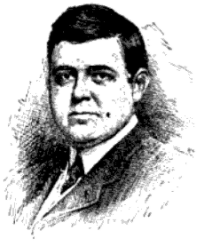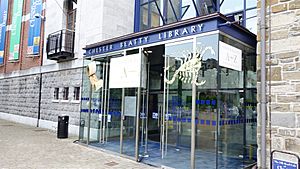Alfred Chester Beatty facts for kids
Quick facts for kids
Alfred Chester Beatty
|
|
|---|---|
 |
|
| Born | 7 February 1875 New York City, US
|
| Died | 19 January 1968 (aged 92) Monte Carlo, Monaco
|
| Education | Columbia School of Mines |
| Occupation | Businessman |
| Spouse(s) |
Grace Rickard
(m. 1900; died 1911)
|
| Signature | |
Sir Alfred Chester Beatty (born February 7, 1875 – died January 19, 1968) was a very successful American-British businessman and generous giver. He made a huge fortune in mining, especially copper, which earned him the nickname "the King of Copper". He became a British citizen in 1933 and was later made a knight in 1954. In 1957, he became an honorary citizen of Ireland.
Chester Beatty loved collecting things from all over the world. His collection included old writings, rare books, and beautiful art from Africa, Asia, Europe, and the Middle East. After moving to Dublin, Ireland, in 1950, he opened the Chester Beatty Library in 1954 to share his amazing collection with everyone. He later gave his entire collection to the people of Ireland. He also donated many ancient papyrus documents to the British Museum and some paintings to the National Gallery of Ireland. He even helped expand a cancer research center, which was renamed the Chester Beatty Institute in his honor.
Early Life and Mining Success
Alfred Chester Beatty, often called Chester or "Chet" by his friends, was born in New York City in 1875. He was the youngest of three sons. His father was a banker and stockbroker.
After finishing his studies at Columbia School of Mines in 1898, he moved to Denver, Colorado. His first job in the mines paid him just $2 a day. He worked hard, clearing rocks and soil from mine tunnels. Soon, he was promoted to a supervisor role.
He learned a lot from T. A. Rickard, a mining engineer. Rickard also introduced Chester to his sister-in-law, Grace "Ninette" Rickard. Chester and Ninette got married in 1900. In 1903, he joined the management team of the Guggenheim Exploration Company. This job helped him become very wealthy. By 1908, he was known as one of the best mining engineers in the country.
Chester bought a house in New York and started his own business as a mining consultant. Sadly, Grace died suddenly in 1911. In 1912, he bought a large house in London and moved there with his two young children. He soon married his second wife, Edith Dunn. Both Chester and Edith loved collecting art and treasures.
In 1914, Beatty started a mining company in London called Selection Trust. The First World War slowed things down, but in the 1920s, his company grew. It gained interests in countries like the USSR, Ghana, and Sierra Leone. Chester Beatty made most of his money in Africa, especially in places like Northern Rhodesia (now Zambia) and the Belgian Congo (now the Democratic Republic of Congo). He became famous for his work in the "Copper Belt," which is why people called him the "King of Copper."
A Passion for Collecting

Chester Beatty's love for collecting started when he was very young. As a boy, he even bid on mining samples at an auction! He remembered bidding 10 cents on a piece of pink calcite when he was just ten years old. Later, he started collecting stamps, which became a prize-winning collection. Before moving to London, he was already collecting Chinese snuff bottles and Japanese art pieces like netsuke.
Because of a lung condition called silicosis, which he got from working in mines, Chester and his family would spend winters in warmer places like Egypt. During a trip to Cairo in 1913, he became very interested in ancient papyrus and Islamic writings.
In 1931, a newspaper announced that Beatty had bought a very important collection of ancient Bible writings. These are now known as the Chester Beatty Papyri. This discovery changed what experts knew about early Christian texts. These documents, some dating back to the third century, were amazing because they survived difficult times. They also showed that certain parts of the New Testament were accepted as important much earlier than previously thought.
In 1917, after recovering from illness, Chester, Edith, and his daughter traveled to Japan and China. During this trip, he bought many painted albums and scrolls. He continued to buy Chinese, Japanese, and Southeast Asian manuscripts, textiles, and artifacts for the rest of his life.
Chester Beatty became very well-known as a collector. He worked with experts and agents, but he always made the final decision on what to buy. His wife, Edith, also became a serious collector of paintings and furniture. Chester focused on important Islamic works, including beautiful copies of the Quran. He also collected ancient writings from Egypt, Syria, Armenia, and Greece. He loved items with rich illustrations, beautiful bindings, and fine writing. He also wanted to save texts that were important for history. He only collected the best quality items, which became a special mark of his collection.
At first, Beatty was a strong competitor in the art market. But in 1925, he started working closely with the British Museum. Sometimes, he would buy an object and simply give it to the museum. For one special manuscript, he even agreed to share it with the museum. The Beattys also gave 19 ancient Egyptian papyri to the British Museum.
Between 1939 and 1949, Beatty bought over 140 paintings from the 1800s for his London home. In 1940, he sent these paintings to New York for safety during the Second World War. In 1949, he decided to give some of his French paintings to Ireland. This was a thank you to the Irish leader, John A. Costello, who helped him move from London. These paintings are now part of the collection at the National Gallery of Ireland. One famous painting he donated was The Gleaners by Jules Breton.
Moving to Dublin
Chester Beatty helped a lot during the war by providing raw materials to the Allies. For his efforts, Queen Elizabeth II made him a knight in 1954.
However, by the late 1940s, he was not happy with Britain. He felt that new government rules and high taxes were making it hard for his business and his collecting. He had planned to give his whole collection to the British Museum. But the new director would not promise that his collection would stay together.
In 1950, at 75 years old, Chester Beatty gave control of his company to his son, Chester Jr. He then moved to Dublin, Ireland. Many people were surprised by this move. One reason was his frustration with Britain after the war. He felt that London was no longer the center of the mining world. He said that high taxes and strict rules were stopping new mining projects. There were also personal reasons. His son had bought a home in Ireland in 1948. Chester also had Irish family roots, which made him look kindly on Ireland.
He was also thinking about the future of his collection. He worried it would be split up if he left it to a large institution. So, he found another solution. He built a special library on Shrewsbury Road in Dublin. It opened in 1953 for researchers and later to the public.
He bought a large house for himself in Dublin and a nearby plot of land for the Chester Beatty Library. The library opened on August 8, 1953. It later moved to its current home at Dublin Castle in 2000.
Chester Beatty spent the rest of his life between Dublin and the south of France. He was given the special title of Freeman of Dublin in 1954. In 1957, he was the first person to be given honorary citizenship of Ireland. He continued to collect in the 1950s and 1960s, adding important Ethiopian and Japanese writings to his collection.
Chester Beatty died in Monte Carlo, Monaco, in 1968. The Irish government gave him a state funeral. This was a very rare honor for a private citizen. He is buried in Glasnevin Cemetery in Dublin.
The Chester Beatty Library and its collection were given to a trust for the people of Ireland. In 2000, it moved to its current location in the Clock Tower building at Dublin Castle.
Images for kids


